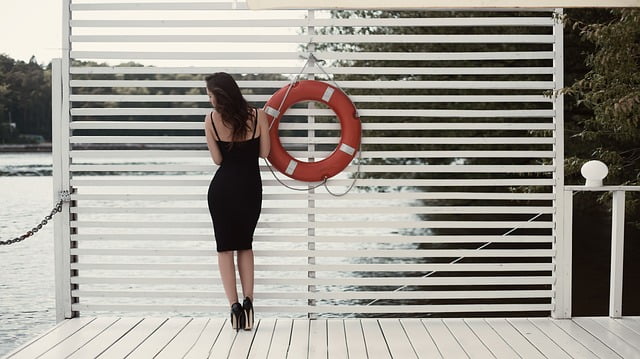Banarasi sarees are more than just a piece of fabric; they represent a way of life. These sarees, known for their grandeur and precise craftsmanship, are more than just traditional attire. They are an emblem of India’s illustrious cultural history. This blog intends to provide you with a comprehensive introduction to Banarasi Saree Types, allowing you to make an informed selection the next time you go shopping for one.
Origin of Banarasi Saree

The Banarasi saree, which originated in Varanasi, formerly known as Banaras, has a major role in Indian history. This sophisticated weaving art form was first imported by the Mughals, who blended it with Indian forms. These sarees have become a standard at Indian weddings and other important occasions over the years. Banarasi sarees are prized for their excellent quality and craftsmanship, making them a family heritage in many households.
The Weaving Process of Banarasi Saree

The weaving of Banarasi sarees requires expertise, patience, and artistry. It entails several phases, each of which demands close attention to detail. The dyeing of the silk is usually followed by warping, weaving, and adding designs, which are commonly done with gold or silver threads (zari). Depending on the complexity of the design, weaving can take anywhere from 15 days to six months. This time-consuming process is what distinguishes and values each piece.
Significance Of Banarasi Sarees

Banarasi sarees have a special position in Indian culture. They are the go-to pick for brides and are frequently passed down through generations as keepsakes due to their grandeur and opulence. The richness of the fabric and the intricate weave make it excellent for formal events such as weddings, festivals, and formal gatherings.
Highlights of Banarasi Sarees

The charm of Banarasi sarees stems from their distinct characteristics and superb craftsmanship. They are distinguished from other types of sarees by their brilliant color palettes, elaborate designs, and exquisite zari work. One of the most notable features is the cloth itself, which is sumptuous, silky, and frequently embellished with actual gold or silver threads. As a result, each Banarasi saree is a work of art in its own right.
Banarasi Saree Types: Types of Banarasi Sarees You Can Choose From
There are numerous Banarasi Saree Types available, catering to a wide range of tastes and events. Some are appropriate for bridal wear, while others are appropriate for less formal occasions. Let’s look at the various types of Banarasi sarees available.
Banarasi Sarees: 4 Fabric Varieties
Silk
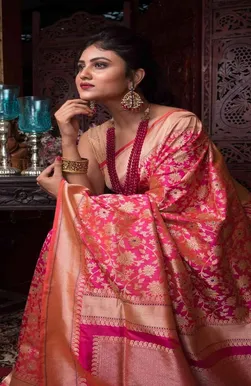
When it comes to Banarasi Saree Types, silk is without a doubt the most celebrated material. Silk sarees are the embodiment of richness and grandeur with their rich texture, lustrous shine, and elegant drape. They are frequently adorned with beautiful zari work, complicated designs, and vibrant hues. When it comes to Banarasi saree types, silk variations are frequently the first choice for significant occasions such as weddings and festivals. They not only represent ancient Indian craftsmanship, but they also provide unsurpassed elegance. Silk sarees are a timeless classic that display the best of Banarasi weaving expertise if you’re looking for Banarasi Saree Types.
Cotton

Cotton is another fabric that has made its way into the wide variety of Banarasi Saree Types. These sarees are well known for their ease, breathability, and lightweight , making them appropriate for everyday use or more casual situations. Cotton Banarasi sarees typically have simpler motifs and less ornate zari work than their silk counterparts. Cotton alternatives offer a blend of history and practicality when it comes to Types Of Banarasi Saree. They are an excellent alternative for individuals looking for the classic appeal of Banarasi sarees but with increased comfort and ease of wear, making them an adaptable addition to any saree collection.
Georgette

Georgette Banarasi sarees are a lighter, more flowing alternative to silk sarees. They are adaptable and can be worn in a variety of circumstances. They combine the magnificence of a classic Banarasi saree with the comfort required for longer usage. So, among Banarasi Saree Types, Georgette should be on your list if you want a mix of design and comfort.
Other Fabrics

Other textiles, in addition to silk and cotton, contribute to the broad inventory of Banarasi Saree Types. Chiffon, organza, and even velvet have been included into the Banarasi weaving heritage. From the breezy lightness of chiffon to the rich touch of velvet, these alternative materials provide a variety of aesthetics and purposes. When it comes to Types Of Banarasi Saree, these various fabrics offer a greater range of options, allowing you to choose a saree that meets your individual demands and circumstances. Exploring these additional materials will extend your enjoyment of Banarasi Saree Types, whether you prefer formality or informal elegance.
Banarasi Saree Types: The 5 Different Designs
When it comes to designs, Banarasi sarees offer an array of options. From floral to geometric patterns, the variety is bound to cater to individual preferences.
Floral

Floral patterns are a compelling feature of the numerous Banarasi Saree Types. These sarees are decorated with beautiful flower designs that are often interlaced with zari or silk threads to create an enchanting garden-like scene on the fabric. Floral Banarasi sarees are ideal for spring festivals, daytime events, or any occasion where you wish to exude youth and vitality. When it comes to Banarasi Saree Types, the floral category offers a unique combination of beauty and traditional craftsmanship. Floral Banarasi sarees, whether made of silk, cotton, or other materials, bring nature’s brilliance to the rich tapestry of Banarasi weaving.
Geometric

Geometric patterns have a special place among the many Banarasi Saree Types. These designs incorporate bold shapes such as squares, triangles, and circles, bringing a modern touch to the traditional craft of Banarasi weaving. Geometric sarees are an eye-catching option for modern occasions or gatherings where you want to make a strong fashion statement. When it comes to Banarasi Saree Types, the geometric category offers a blend of contemporary and age-old artistry. Geometric Banarasi sarees, whether in silk or cotton, are an eye-catching alternative to the more classic designs found in the Banarasi repertoire.
Paisley
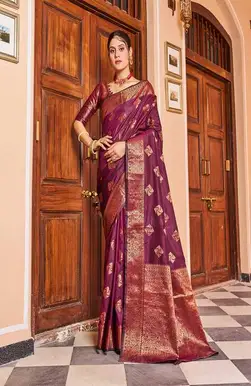
Paisley patterns provide an exotic touch to the variety of Banarasi Saree Types. These elaborate designs, which look like a teardrop or a mango, have their origins in both Persian and Indian traditions. Paisley Banarasi sarees are popular due to their rich symbolism and beautiful workmanship and are often woven with fine silk or zari threads. Among the Banarasi Saree designs, paisley designs stand out for their timeless appeal and cultural significance. These sarees are ideal for instances when you want to wear something both traditional and significant. Paisley Banarasi sarees, with their intricate motifs and cultural heritage, are a unique choice for any saree connoisseur.
Animal Motifs

Animal themes provide a distinct thematic focus among the Banarasi Saree Types. These motifs include peacocks, elephants, and birds and are often delicately woven with exquisite silk or zari threads. Animal motifs add a storytelling element to Types Of Banarasi Saree, capturing the imagination. These sarees are an excellent choice for situations where you want to highlight a work of art as well as an item of apparel. Animal-themed Banarasi sarees offer a one-of-a-kind experience, combining heritage and whimsy, and are ideal for people wishing to make a memorable fashion statement.
Others

While we’ve covered a lot of ground, the world of Banarasi Saree Types is far from over. Other designs and themes available include cosmic motifs, architectural patterns, and even abstract art. These “others” enhance the scope and appeal of Banarasi Saree Types, providing something for every taste and occasion. Exploring these other alternatives can be really gratifying, whether you’re seeking something extremely unique or a saree that matches a very specific motif. So, don’t limit yourself to the well-known Banarasi Saree Types; often the most spectacular pearls can be found in the most unexpected corners of Banarasi Saree Types.
Banarasi Sarees by Material and Weave
Besides fabric and design, the material and weave also contribute to the unique Banarasi Saree Types.
Material Types
Shattir

Shattir is one of the less well-known yet highly appreciated Banarasi Saree Types. Shattir sarees are designed for more relaxed situations and offer the perfect combination of simplicity and elegance. They are often made of a silk and other synthetic material blend, which gives them a lightweight and breathable characteristic. Shattir provides a more approachable entrance point for people new to the world of Banarasi sarees when addressing Types Of Banarasi Sarees. It has the grandeur associated with Banarasi weaves, yet it is more subdued. Shattir is a versatile choice for individuals looking for a mix of modernity and heritage in Banarasi Saree Types.
Katan

Katan is one of the original Banarasi Saree Types, typically fashioned from pure silk threads. These sarees are noted for their sumptuous feel, timeless charm, and meticulous handloom weaving. Katan sarees are popular for weddings and major celebrations because of their rich designs and zari work. When it comes to Banarasi Saree Types, Katan stands out for its pure silk quality and craftsmanship, which mirror the rich heritage of Indian textiles. A Katan saree is frequently regarded as the finest choice for individuals looking to experience the pinnacle of traditional weaving skills among Banarasi Saree Types.
Georgette

Georgette is a lightweight, flowing fabric that has made its way onto the renowned Banarasi Saree Types List. Georgette Banarasi sarees are known for their breathable and easy-to-drape nature, and they frequently contain brilliant colors and dramatic designs accented with exquisite zari work or embroidery. Georgette sarees are a fantastic alternative for Types Of Banarasi Sarees for everyday wear or less formal situations.
Weave Types
Shikargarh

Shikargarh is a specialty style among Banarasi Saree Types that is well-known for its hunting themes and wildlife elements. The Shikargarh pattern, which dates back to the Mughal Empire, typically features complex images of animals, trees, and hunters that are weaved into the saree using fine silk or gold threads. This distinct motif distinguishes it from other types of Banarasi sarees, making it a collector’s item and frequently a family legacy. Shikargarh sarees are often regarded as ideal for great occasions such as weddings and major festivities due to the elaborate embroidery. Shikargarh offers a historical and aesthetic touch to the traditional saree when researching Banarasi Saree Types.
Tanchoi

Tanchoi is a unique weaving method that originated in China but has now become an essential component of Banarasi Saree Types. These sarees are distinguished by complex patterns woven into the cloth, which frequently feature paisley motifs or floral themes. Tanchoi sarees have a more textured feel than other types of Banarasi sarees because of the additional weft threads, giving them a distinct richness. They are often composed of silk and are lighter in weight than traditional Banarasi sarees, making them appropriate for a wide range of occasions. Tanchoi sarees, with their distinct texture and elaborate motifs, combine heritage and sophistication.
Butidar

Butidar is one of the most opulent Banarasi Saree Types, known for its rich, detailed designs. The name “Butidar” refers to a saree having motifs or ‘butis’ that are commonly woven with gold, silver, or silk threads. This produces a brilliant, shimmering look that adds luxury to any occasion. Butidar sarees stand out among Banarasi Saree Types for their lavishness and meticulous craftsmanship. These sarees are typically chosen for major events such as weddings and other celebrations because they exemplify the majesty and magnificence that Banarasi sarees are known for.
Specialized Banarasi Saree Types
Cut Work Sarees

Cut-work sarees are a unique group within the Banarasi Saree Types spectrum. These sarees are known for their distinctive ‘cut work’ on the borders, which resembles lace. The intricate work is produced by eliminating threads in the warp and weft, leaving behind a lovely, lattice-like design, and is primarily made of silk or silk blends. Cutwork sarees are a beautiful blend of traditional craftsmanship and contemporary aesthetics when it comes to Types Of Banarasi Sarees for festive occasions or weddings. Because of their delicate and exquisite patterns, they are a versatile choice for both major occasions and private gatherings.
Jangla
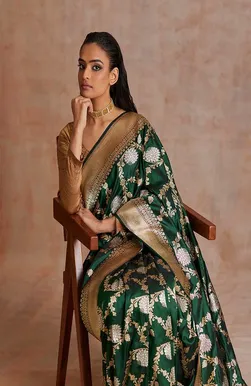
Jangla is one of the ancient Banarasi Saree Types that is admired for its intricate designs. These sarees have intricate designs woven all the way down the length, frequently depicting bright forest scenes or complicated motifs. The Jangla design, which is primarily made of silk, is a tribute to the superb craftsmanship that goes into Banarasi sarees. Each saree takes a long time and effort to weave, making it a valuable property. When it comes to Banarasi Saree Types, the Jangla stands out for its rich complexity and intricate artistry, making it a prized choice for special occasions and celebrations.
Tissue Sarees

Tissue sarees are an intriguing addition to the Banarasi Saree Types. Tissue sarees are known for their translucent, shimmering texture and are frequently woven with a blend of silk and metallic threads, giving them a lustrous gloss. These sarees are ideal for evening events where you want to make a big statement. The fabric’s light-catching quality, mixed with exquisite patterns and zari work, creates an ethereal aesthetic. Tissue sarees offer a distinct blend of elegance and glamour when it comes to Types Of Banarasi Sarees for special occasions, making them a favorite choice among those who value refined luxury.
Jamdani Sarees

Jamdani Sarees are distinct among the different Banarasi Saree Types. These sarees are traditionally woven in Varanasi and are a rich combination of cotton and gold thread, making them both breathable and sumptuous. Jamdani weaving is an ancient technique that entails elaborate, hand-woven designs, typically of floral and geometric shapes. The end product is a lightweight yet elegant saree that may be worn on a variety of occasions. When it comes to Banarasi Saree Types, Jamdani sarees are a lovely option for people looking for a mix of history, comfort, and elegance.
Banarasi Silk Shalu

Banarasi Silk Shalu is one of the most beautiful Banarasi Saree Types, distinguished by its rich hues and elaborate zari work. These sarees, which are traditionally worn during important rituals such as weddings and festivals, are a symbol of India’s rich cultural tapestry. They are made of fine silk and have a beautiful sheen that gives a sense of grandeur to any event. The Banarasi Silk Shalu encapsulates a sense of elegance and heritage with complex designs frequently woven in gold or silver threads. When it comes to Banarasi Saree Types, this one stands out for its unparalleled beauty and luxury.
Organza (Kora) Saree
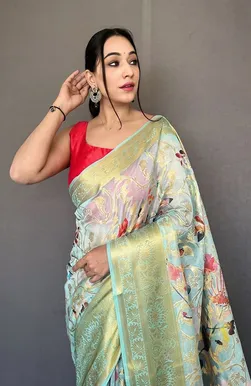
Organza, also known as Kora, is one of the most popular Banarasi Saree Types due to its lightweight texture and crisp finish. These sarees are made of synthetic fiber or silk and have a transparent appearance, making them a popular choice for summer weddings and daytime festivities. Though lighter than conventional silk Banarasi sarees, they nonetheless radiate grandeur, with elaborate zari work and detailed designs. When it comes to Banarasi Saree Types, an Organza (Kora) saree is an excellent choice for individuals seeking elegance as well as comfort.
Conclusion
With so many Banarasi Saree Types to pick from, you’ll never be out of alternatives. The alternatives are unlimited, whether you want something classic like a silk Banarasi saree with elaborate embellishments or something modern like a Georgette Banarasi saree with geometric designs.
So, the next time you’re looking for the perfect saree, let this advice aid you in selecting a Banarasi saree that not only complements your style but also symbolizes the rich cultural legacy that these beauties represent.
FAQs On Banarasi Saree Types
1. Is silk used in all Banarasi sarees?
No, Banarasi sarees may be manufactured from a variety of fabrics, such as silk, cotton, georgette, and others.
2. What are the appropriate situations for wearing Banarasi sarees?
Banarasi sarees add a sense of elegance to weddings, festivals, celebrations, and formal gatherings.
3. How can I maintain the beauty of my Banarasi saree?
Handwashing with a light detergent and storage in a cool, dry area can help maintain the saree’s attractiveness.
4. Are Banarasi sarees inexpensive, or do they come in various price ranges?
Banarasi sarees are priced differently based on the material, pattern, and craftsmanship.
5. What are some of the distinctive design aspects present in Banarasi Saree Types?
Banarasi sarees have elaborate zari work, paisley patterns, and animal themes.








